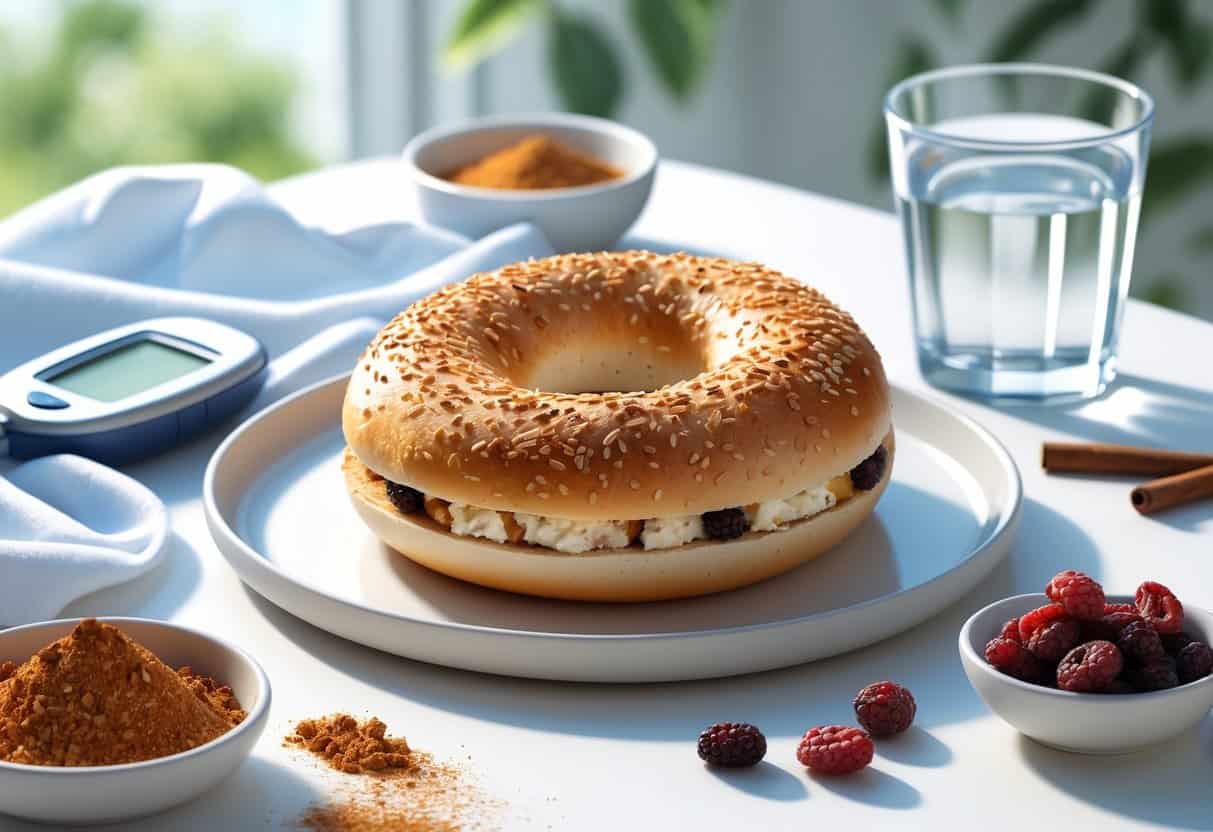Cinnamon raisin bagels are a breakfast favorite for many. But if you have diabetes, you might be asking yourself whether they’re a smart choice.
Short answer? You can eat cinnamon raisin bagels, but you’ve got to watch portions and how often you indulge. They’re usually loaded with sugar and carbs, which can send your blood sugar on a rollercoaster.

Bagels with added sugar or fruit, like raisins, tend to spike blood sugar for a lot of folks with diabetes. Sometimes, going for a plain bagel or one with less sugar is just the safer bet.
It’s important to keep tabs on your total carb intake, especially if you’re adding any bagel to your meal.
If you’re set on having a cinnamon raisin bagel, knowing how to balance your blood sugar is crucial. Serving size matters, and pairing bagels with protein or healthy fats can help ease the impact.
Key Takeaways
- Cinnamon raisin bagels are high in carbs and sugar, so keep them as an occasional treat.
- Skip bagels with extra sugars if you want steadier blood glucose.
- Pairing bagels with protein or fat can help soften blood sugar spikes.
Cinnamon Raisin Bagels and Diabetes
Cinnamon raisin bagels pack a mix of carbs that can drive up your blood sugar. Raisins and added sugar only ramp up the carb count, so be extra mindful if you have type 2 diabetes.
Glycemic Index and Blood Sugar Impact
Cinnamon raisin bagels usually score high on the glycemic index (GI). That means they can make your blood sugar climb fast after eating.
Bagels start with refined flour, which is already high GI. Toss in raisins, and you’ve got even more carbs to handle.
If you’re craving one, maybe try just half a bagel to keep things in check.
Role of Added Sugar and Raisins in Bagels
Extra sugar in cinnamon raisin bagels makes them less ideal for people with diabetes. A lot of store-bought bagels have added sugars for flavor, which only bumps up the carb load.
Raisins bring their own natural sugars. Sure, they add some nutrients and taste, but they also add to the carb count.
If you really want a cinnamon raisin bagel, look for ones with less added sugar. Or, eat it alongside some protein or fat to slow down the sugar rush.
Nutritional Profile of Cinnamon Raisin Bagels
Cinnamon raisin bagels are heavy on carbs, with a bit of fiber thrown in. Knowing what’s inside helps you make better choices if you’re watching your blood sugar.
Carbohydrates and Dietary Fiber Content
A typical cinnamon raisin bagel has about 45 to 50 grams of carbs. Most of those come from flour and raisins.
That’s a lot, and it means your blood sugar can jump pretty quickly after eating one.
Dietary fiber is usually just 2 to 3 grams per bagel. Fiber helps slow down digestion and can take the edge off blood sugar spikes, but honestly, that amount might not be enough to make a big difference.
If you want more fiber, go for whole grain bagels or add fiber-rich toppings. It can help with digestion, too.
Whole Grains, Flours, and Ingredients
Most cinnamon raisin bagels are made with refined white flour. That stuff has less fiber and fewer nutrients than whole grain flour.
Refined flours make your blood sugar climb faster. If you can find a whole grain version, that’s a better call for blood sugar control.
Sometimes you’ll spot ingredients like rice bran in whole grain bagels, which adds fiber and nutrients. Look for “whole wheat flour” or “whole grain” on the label for a better pick.
Cinnamon and raisins bring flavor, but raisins are calorie-dense and push the glycemic load higher.
Strategies for Healthier Eating With Diabetes
Managing blood sugar is all about smart choices and portion control. Adding protein and healthy fats to your meals can slow down how fast your blood sugar rises.
Planning your portions helps keep things balanced and avoids those nasty glucose spikes.
Pairing Bagels With Protein and Healthy Fats
If you’re having a cinnamon raisin bagel, try adding lean protein like turkey, chicken breast, or seafood. That helps balance out the carbs and keeps you feeling full.
Healthy fats—think olive oil, nuts, or avocado—also slow digestion and can help prevent blood sugar from spiking.
Throw in some veggies like spinach or tomatoes for extra fiber and nutrients. Swap butter for a light spread of olive oil or low-fat cream cheese.
Mixing these together keeps your meal more balanced and supports steadier blood sugar.
Portion Control and Meal Planning
Keep your bagel portions small, or just split one with a friend to cut down on carbs. Maybe just eat half a cinnamon raisin bagel and add a side of fresh fruit or a small salad with a drizzle of olive oil.
Try to plan meals with whole grains like brown rice, some legumes, and plenty of veggies. Mixing things up this way seems to help your body handle carbs a bit better.
Spacing out meals and snacks so you don’t go too long without eating can help prevent those annoying blood sugar swings. Using meal planning tools or jotting down what you eat in a food diary might make it easier to keep track of portions.
And hey, don’t forget to pat yourself on the back with a healthy, low-fat meal when you hit your goals.